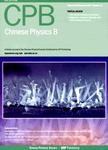Mn overlayers on PbTe(111): Substitutional adsorption and interface formation
Mn overlayers on PbTe(111): Substitutional adsorption and interface formation作者机构:Department of Physics Zhejiang University Department of Physics Shaoxing University Department of Materials Science and Engineering Zhejiang University
出 版 物:《Chinese Physics B》 (中国物理B(英文版))
年 卷 期:2014年第23卷第12期
页 面:497-501页
核心收录:
学科分类:07[理学] 070205[理学-凝聚态物理] 0805[工学-材料科学与工程(可授工学、理学学位)] 0704[理学-天文学] 0702[理学-物理学]
基 金:Project supported by the National Natural Science Foundation of China(Grant Nos.11074214,51202149,and 11204180) the Natural Science Foun-dation of Zhejiang Province,China(Grant No.LQ12F04001) the Scientific Research Fund of Zhejiang Provincial Education Department,China(Grant No.Y201121234) the Ministry of Science and Technology of China
主 题:photoemission spectrum metal–semiconductor electronic structure PbTe
摘 要:The formation of the Mn/Pb Te(111) interface is investigated by photoemission spectrum. The core level behavior of Mn 2p is consistent with Mn substitutional adsorption during the initial Mn deposition, forming a(√3 ×√3)R30?-Pb0.67Mn0.33 Te phase of the second layer. Further deposition of Mn can cause metallic Mn islands to cover the substitutional substrate. Ultraviolet photoemission measurements show that the Fermi level is shifted into the conduction band, indicating Ohmic contact formation at the Mn/Pb Te(111) interface. The valence band maximum associated with the Pb0.67Mn0.33 Te layer is located at 1.27 e V below the Fermi level, and a schematic electronic structure of the Mn/Pb Te(111)interface is given. The work function of the substituted substrate with Pb-covered Mn islands is determined to be 4.16 e V,in comparison with 4.35 e V for the Pb-covered substituted substrate and 3.95 e V for the pristine Pb Te(111) surface.



